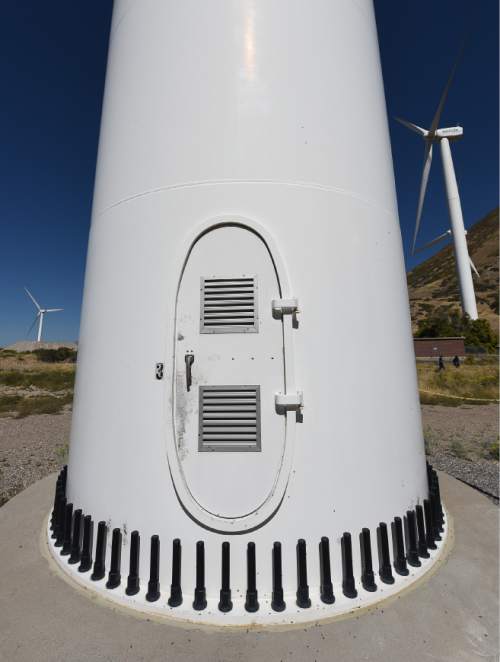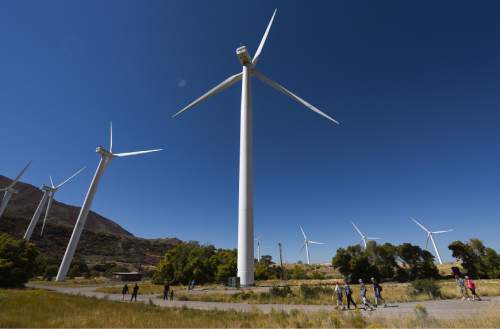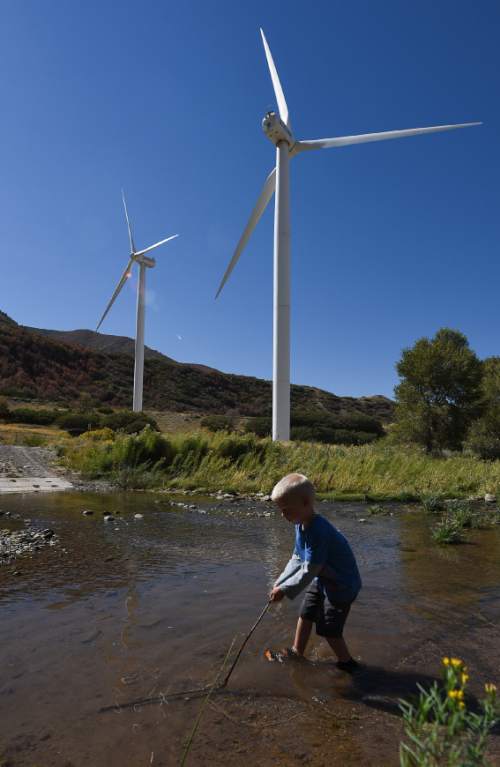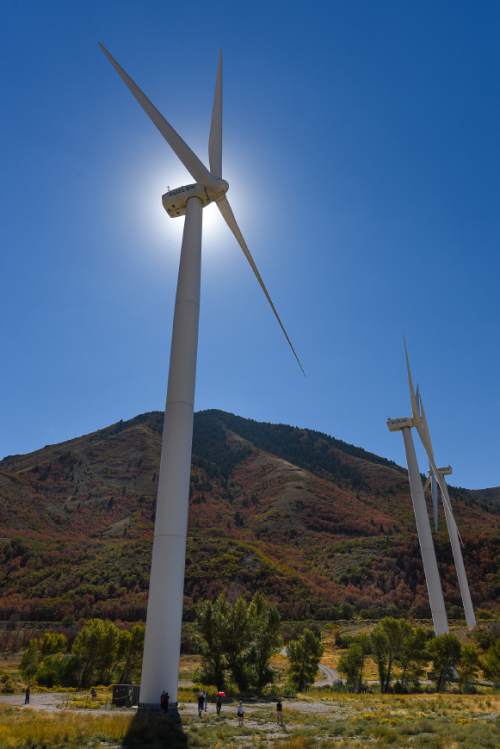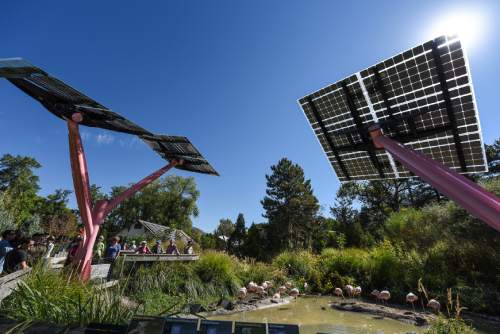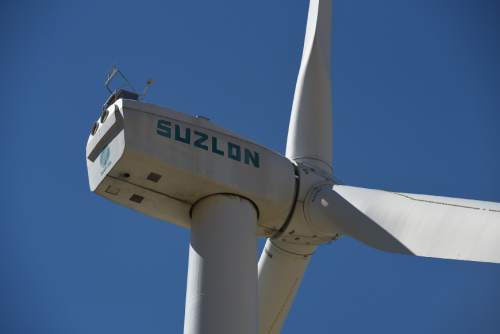This is an archived article that was published on sltrib.com in 2015, and information in the article may be outdated. It is provided only for personal research purposes and may not be reprinted.
There was once a time when electricity was a sort of magic; power lines and plants were laudable symbols of progress.
The situation today is a little different.
"Older people had more of an appreciation for just having electricity, so everything the company did was good," said Rocky Mountain Power spokesman Dave Eskelsen. "Younger generations have higher expectations."
Rocky Mountain Power's 2015 Integrated Resource Plan (IRP) — an outline for providing power to customers for the next 20 years — has drawn significant criticism from local and national environmental groups in recent months. The issue isn't what Rocky Mountain Power plans to build, but rather what environmentalists say the company refuses to build: more renewable energy resources.
"All the work that its attorneys and executives do to shun renewable energy [is done] in arcane regulatory processes hidden from public view," HEAL Utah's Brown Sky report reads. "The advocates, attorneys and renewable-energy entrepreneurs who pay close attention to Rocky Mountain Power ... have learned the utility has apparently never met a renewable energy program it couldn't fight."
The HEAL report, which asserts that "Utah has the worst record in the West" for utilizing renewable energy resources, takes aim at Rocky Mountain Power's Blue Sky program, which is intended to allow power customers throughout the West to invest in renewable energy. Residents can electively purchase 100-kilowatt-hour "blocks" of renewable energy for $1.95 per month. The money is used to subsidize independent wind and solar projects, or provide grants for small-scale renewable energy projects, like installing solar panels on a business' roof.
But, HEAL points out, none of this energy is actually delivered to the Blue Sky customer.
"Even if the customer does commit to buy 10 blocks, for $19.50 a month, or $234 a year, to supposedly 'cover about 100 percent' of home electrical use, his or her home is still powered by the same overall mix of Rocky Mountain Power energy," the Brown Sky report says.
On a recent tour for Blue Sky customers and media, Rocky Mountain Power representatives said the energy blocks were originally intended to buy power directly from independent sources of renewable energy. But when the price of renewable energy dropped, the company was left with a surplus of funds from the Blue Sky program. That surplus, they said, is used to fund grants for renewable energy projects.
Altogether, Blue Sky customers have funded the creation of 5.5 billion kilowatt hours of renewable energy, preventing 3.3 million tons of greenhouse gases from entering the atmosphere, said Chad Ambrose, a regional business manager for Rocky Mountain Power.
But all these projects, according to HEAL, do little to change the mix of resources used to generate electricity in Utah. According to the company's data, 61 percent of Rocky Mountain Power electricity is generated at coal-fired plants, about 6 percent at hydroelectric plants, and 9 percent is from other renewable sources.
HEAL Utah believes Rocky Mountain Power overstates those ratios, but Eskelsen noted that the numbers "are reviewed by state and federal regulators and we stand by their accuracy."
HEAL also points out that the utility acknowledges about 31 percent of the renewable energy it generates is either sold to third parties or is not captured and delivered to customers.
Rocky Mountain Power's motive for this, advocates say, is profit — and the more large assets, such as coal power plants, that the company owns, the more profit it makes.
There's truth to Heal Utah's assertion that Rocky Mountain Power is focused on the bottom line, Eskelsen said.
"It doesn't matter to a utility what it uses to generate electricity," he said. "We only care whether we recover our costs."
That goal has Rocky Mountain Power edging toward a mix of wind farms and natural-gas power plants to meet future energy needs.
Wind and natural gas are among the cheapest power sources, with both generating power at an approximate cost of 8 cents per kilowatt hour. Solar, on the other hand, ranges from 10 cents to 20 cents per kilowatt hour, although Eskelsen said it is becoming increasingly viable as improved technologies reduce the cost. Hydropower is even cheaper, but there aren't a lot of viable waterways left for additional development.
Rocky Mountain Power generates coal power at an estimated cost of 3 to 4 cents per kilowatt hour, Eskelsen said, though that price can't be compared directly with the estimates for solar or wind. The company figures the cost of building new resources into the overall price of power, he said, and coal power is cheaper because Rocky Mountain Power has already built those plants.
And though wind power is great from the utility's perspective because it is relatively cheap, it's available only when the wind is actually blowing — about 30 percent of the time. That's where natural-gas plants come in. Capable of powering up at a moment's notice, the natural-gas plants can be brought online when wind production drops off.
By 2034, Rocky Mountain Power intends to reduce its reliance on coal to 31 percent, according to the company's IRP. The utility plans to invest 41 percent of its generation capacity in natural gas, 4 percent in hydropower and 7 percent in renewable resources.
Technological developments could change the company's 20-year plan. A viable commercial-scale technology for storing wind and solar energy would make renewable power more viable from the utility's perspective, Eskelsen said. "We're willing to consider anything that makes sense for our customers."
Not everyone is buying that rhetoric. The national Sierra Club analyzed the methodology of Rocky Mountain Power's 2015 IRP and concluded the utility was inputting parameters into cost-modeling software that would sway what came out as the least-cost scenario.
Lindsay Beebe, the organizing representative for the Sierra Club's Beyond Coal initiative, said her organization's analysts believe Rocky Mountain Power manually assigned each coal power plant a set retirement date, preventing the software from calculating what alternatives would be cost effective if coal plant closures came earlier.
"Without the manipulation, the lowest cost model seeks to retire five coal power plants at an earlier date than when the company deems appropriate," Beebe said.
Rocky Mountain Power's modeling also overestimates the cost of wind power by 18 percent and the cost of solar by 30 percent, Beebe said.
"And it's good to keep in mind that the price tag to keep some of these old and dirty plants is estimated to be $1.3 billion, and those costs are thought to be passed on to the customer," she said. "The manipulation of the scales is probably meant to protect their investments in coal at the cost of the customer."
Twitter: @EmaPen



